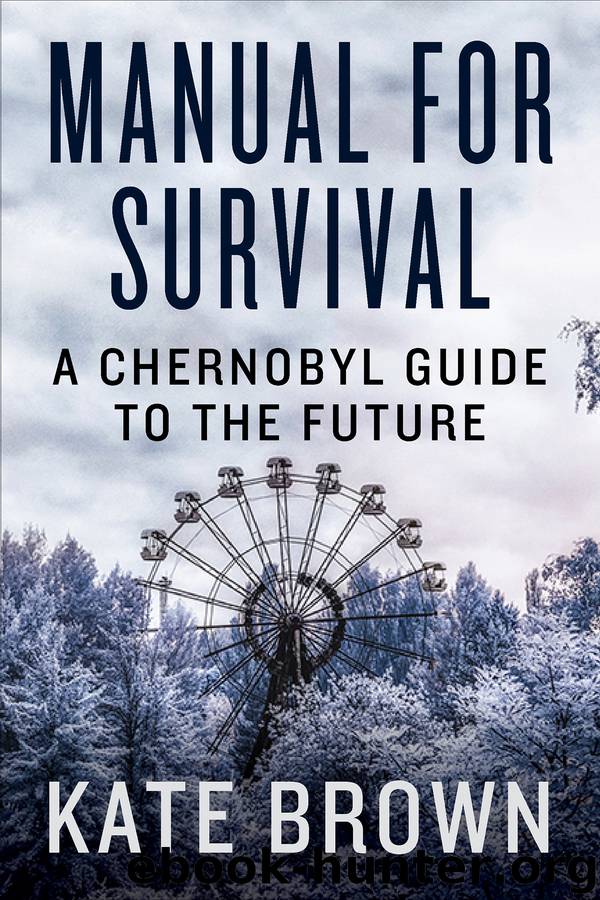Manual for Survival: A Chernobyl Guide to the Future by Kate Brown

Author:Kate Brown
Language: eng
Format: epub
Publisher: W. W. Norton
Published: 2019-03-12T00:00:00+00:00
In Search of Catastrophe
In the spring of 1990, the IAEA mounted a major effort to assess Chernobyl damage, and Abel Gonzalez managed it. He recruited two hundred volunteer scientists categorized into groups—dosimetry, history, health, and social consequences.1 The first thing IAEA investigators needed to know was how much radiation was out there. So, in the summer of 1990, small IAEA teams dropped onto Chernobyl contaminated lands on a hunt with no quarry. The international experts sought the measurements of bygone jets of elusive radioactive energy. The experts complained that their Soviet partners, especially the Belarusians, withheld information and maps with radiation levels, doses, and calculations.2 Soviet science managers were under strict orders not to release data to visiting foreigners. Even sick children were considered “biological material” and not to be shared.3 For their part, Soviet scientists complained that the IAEA experts, in their quick, two-week trips, one parachuting after another, landed at the same institutes, in the same small towns, asking for the same information with no apparent knowledge of earlier missions.4 The IAEA teams, which Gonzalez created to avoid inefficiency and duplication, were inefficient and redundant. Apparently, many international scientists were enthusiastic about a junket to the closed Chernobyl regions to see what was billed as the world’s most radioactive zone. The foreigners were less interested in writing reports or returning for multiple visits to cold Soviet hotels with cranky staff and bad food.5
The IAEA teams visited Kyiv’s All-Union Center for Radiation Medicine and the Moscow Institute of Bio-physics, Leonid Ilyin’s institution, which had carefully managed and controlled Chernobyl data since 1986. Everywhere the IAEA consultants went, KGB agents accompanied them, posing as interpreters. Gonzalez laughed about the surveillance between the two camps of scientists. He described to me his “KGB-interpreters.” He reported, “They were smart guys. One told me that a scientist in our group was working for Israeli intelligence. I found out later he was absolutely correct.”6
KGB agents in Ukraine especially suspected the IAEA and WHO as covers for foreign spies. And that is how Soviet security used UN agencies themselves, as hosts for undercover agents abroad. The mutual suspicions put a damper on scientific exchange. The IAEA missions were looking for dose measurements drawn from Chernobyl-exposed people in the years after the accident. The Soviets had compiled a federal registry of over a million Chernobyl survivors. The secretive Third Department in charge of radiation medicine at the Ministry of Health was the clearinghouse for most of the dose data, but it was well known that the department did not share information.7 It was the KGB’s job to prevent foreigners from getting hold of this material and they kept it locked up in safes.8
These were the closely watched parameters of joint Chernobyl research across the Iron Curtain. KGB agents posing as scientists sat down at formal banquets to share mayonnaise-fortified salads with Western spies masquerading as scientific administrators. Each eyed the other knowingly. Maybe they had a secret handshake.
IAEA teams flew to Belarus, where researchers at the Academy of Sciences described the full range of health problems they saw after Chernobyl exposures.
Download
This site does not store any files on its server. We only index and link to content provided by other sites. Please contact the content providers to delete copyright contents if any and email us, we'll remove relevant links or contents immediately.
The Secret History by Donna Tartt(16611)
The Social Justice Warrior Handbook by Lisa De Pasquale(11486)
Thirteen Reasons Why by Jay Asher(7783)
This Is How You Lose Her by Junot Diaz(5754)
Weapons of Math Destruction by Cathy O'Neil(5032)
Zero to One by Peter Thiel(4818)
The Myth of the Strong Leader by Archie Brown(4786)
Promise Me, Dad by Joe Biden(4441)
Stone's Rules by Roger Stone(4413)
Beartown by Fredrik Backman(4406)
How Democracies Die by Steven Levitsky & Daniel Ziblatt(4393)
The Fire Next Time by James Baldwin(4338)
100 Deadly Skills by Clint Emerson(4072)
A Higher Loyalty: Truth, Lies, and Leadership by James Comey(4027)
Rise and Kill First by Ronen Bergman(4009)
The David Icke Guide to the Global Conspiracy (and how to end it) by David Icke(3876)
The Farm by Tom Rob Smith(3870)
Secrecy World by Jake Bernstein(3774)
The Doomsday Machine by Daniel Ellsberg(3726)
